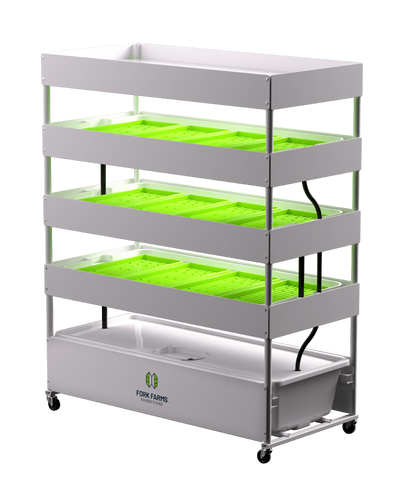Student Engagement Strategies That Work
With a range of online and offline educational resources to explore, it’s a great time for educators to find new ways to keep their students meaningfully engaged in the classroom. These opportunities can empower teachers to create student engagement strategies grounded in collaboration, enabling students to learn and grow together. Through lessons focused on communication and teamwork, teachers can find innovative ways to combine tech with hands-on learning, helping students master a spectrum of interpersonal and otherwise challenging STEM skills.
The Keys to Student Engagement Strategies That Work
An article by Temple University cites the importance of socialization in the classroom, citing researcher Avi Wolfman-Arent. Arent says "that social skills don't just develop on their own; they develop in situations where one must interact with their peers." There are a few ways to create this thoughtful environment for students, including:
- Hands-on-learning opportunities - By actively involving students in the learning process, students can engage in immersive activities that allow students to apply concepts they learn to real-life situations.
- Collaborative Learning - Collaborative learning brings students together and helps to foster a sense of community within the classroom. This can be done through group projects, peer teaching, and collaborative problem-solving. Shared learning also works to develop community ownership and enhance teamwork, engagement, and effective communication skills.
- Real-World Connections - When you can relate lesson content to real-world scenarios, students can understand the practical applications of what they're learning, leading to higher engagement and motivation to learn.
Teachers can also improve their student engagement strategies by balancing technology with hands-on learning. A few tactics to complement in-person lessons could be:
- Technology Integration - By utilizing educational technology tools, such as interactive apps, online quizzes, and multimedia presentations, teachers can enhance engagement and make learning more interactive and interesting.
- Gamification - Gamification can help introduce elements of games into the learning process. Educational games and quizzes can make learning fun and interactive, motivating students to participate actively.
- Use of Multimedia - You can use videos, images, and audio clips to supplement lessons. Multimedia elements can capture students' attention and enhance their understanding of complex topics.
Any of these approaches can make STEM (science, technology, engineering, and math) more engaging and fun while nurturing critical collaboration skills for students.
Hydroponic Growing for Student Engagement
With so many communities and organizations investing in sustainable practices, many classrooms are implementing indoor hydroponics systems into their student engagement strategies. Hydroponics, a technique that allows farmers and individuals to grow crops indoors, helps meet pressing world issues such as climate change and hunger. So, how does hydroponic farming work as an in-classroom learning tool?
In our experience solving the student engagement gap, a functioning indoor hydroponics system actively involves students learning through doing and experiencing things directly. Students can get involved in setting up and maintaining hydroponic farms, preparing nutrient solutions, and monitoring plant growth. In-person discussions on hydroponics can also nurture critical thinking, problem-solving, and analytical skills. Teachers can get the best possible student engagement from hydroponics by integrating this hands-on learning, interdisciplinary education, and technology.
Additional benefits of hydroponics that can inspire lesson plans include:
Environmental Awareness & Sustainability
Given that the hydroponics industry is rapidly growing and evolving, it's never been a better time to educate the future on sustainable practices. By having an in-class unit, students can understand hydroponics' role in sustainable agriculture, reducing water and land usage compared to traditional farming methods. Teachers can also explore broader implications such as food security, waste reduction, and the importance of balanced food production. Additionally, hydroponics can inspire discussions on the benefits of localized food production and reduced carbon emissions associated with transportation.
Community Engagement & Collaboration
A hydroponic system in the classroom can also inspire community-oriented hydroponic projects. Teachers can collaborate with nonprofits and urban agriculture initiatives, helping to emphasize the benefits of shared learning, collaboration, and community ownership. This can also positively impact social skills, effective communication, and teamwork among students and community members.
Career Exploration
Exploring hydroponic farming in the classroom also introduces students to potential career options. For example, students can learn about agricultural methods applicable to large-scale operations. Teachers can explore lessons in nutrient management, plant propagation, and data analysis relevant to careers in horticulture, agriculture, engineering, and environmental science.
Hydroponics & Engagement Benefits Summary
With the potential for building skills in critical thinking, problem-solving, and hands-on learning in STEM education, hydroponics cultivates environmental stewardship and prepares students for future challenges. Hydroponic farming also encourages creative community engagement and its potential to ignite students' passion for sustainable practices and future careers.
Hands-On Learning for Critical Thinking & Problem-Solving Skills
Our Flex Farm and its 30-day growth cycle is a great way to stimulate students and engage them in immersive growth activities that allow them to apply concepts in real-life situations. This approach emphasizes practical learning and is often interactive, encouraging students to explore, experiment, and solve problems. Our digital learning platform, Farmative, also provides educational resources designed to drive student engagement. The K-12 curriculum complements classroom hydroponic learning and empowers students with comprehensive knowledge in STEM, nutrition, and sustainability education.
Grow student engagement by growing fresh food. Turn disengaged students into hungry learners and future changemakers. See how it works today!
Important Links:
























